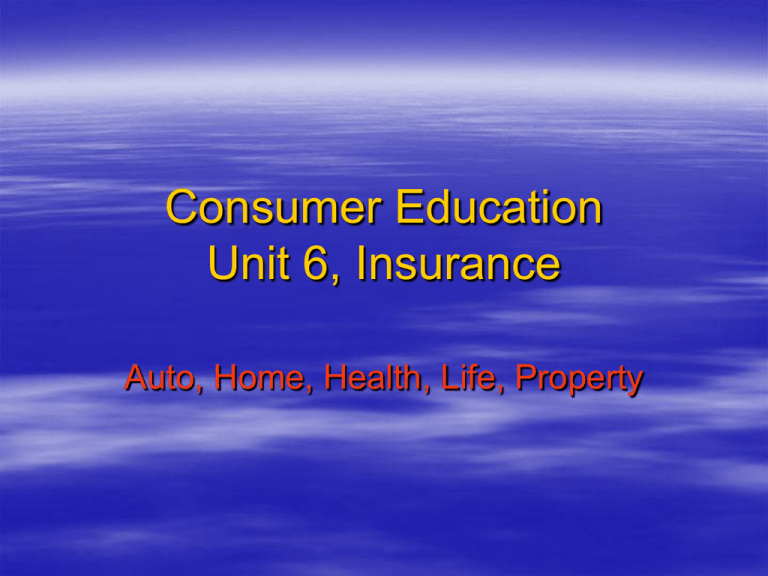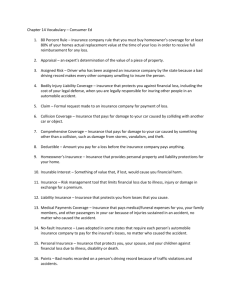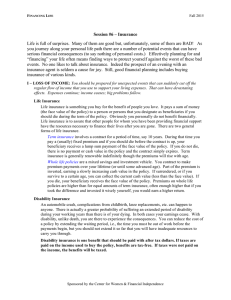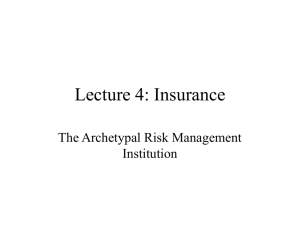Consumer Education Unit 6, Insurance Auto, Home, Health, Life, Property
advertisement

Consumer Education Unit 6, Insurance Auto, Home, Health, Life, Property Insurance Basics To manage your risk of financial loss from illness, injury, or damage, you can buy insurance. In exchange for this protection, you make a regular payment to the insurance company called a premium. When you purchase insurance, you sign a legal contract called a policy. A formal request for payment from an insurance company occurs when one files a claim. A claim is filed when an individual incurs loss covered by a policy. What can be Insured? What Insurance Protects The goal of insurance is to restore your financial position to where you were before the loss – not to allow you to profit from the loss. What is wrong with insuring a $300,000 house for $400,000? You must have an insurable interest in an item to insure that item. The item must be something of value that, if lost, would cause you financial harm. If unclear, insurable interest is determined by an appraisal, or an expert’s determination of the value of a piece of property. A rider can also be used to cover special additions to an insurance policy that covers a specific type of loss (wedding rings, art work, memorabilia, etc.) The Insurance Trade-Off The more insurance coverage you buy, the higher the premiums, or money spent on insurance. At some point, the premiums themselves could put an individual in financial difficulty. A consumer must always analyze the costs and benefits before making important decisions. Role of Insurance in the Economy Many Businesses Would not Exist Without the Insurance Industry Banks would not lend money to homeowners for fear of fire ruining the investment Doctors would not practice medicine for fear of lawsuits A capitalistic economy relies on an insurance system to protect financial holdings. The Three Basic Types of Insurance Designed for Consumers: Property Insurance insurance that protects you from financial loss when things you own are stolen, damaged, or destroyed (home, car, and valuable possessions) Liability Insurance protects you from losses that you cause others (car, home) Personal Insurance insurance that protects you, your spouse, and your children against financial loss due to illness, disability, or death (health and life insurance) What Insurance Company Should An Individual Choose? Considerations: 1. The company’s ability to explain insurance language and policy options (ability to answer questions) 2. Quality of advice about the amount and kinds of coverage to buy 3. Availability in time of need 4. Helpfulness in guiding you through the claims process 5. Speed in getting claims paid 6. Overall friendly, patient, and cooperative nature 7. Financial health of the company and price of coverage Automobile Insurance Automobile Insurance Types of Coverage Bodily Injury Liability Protects a consumer against financial loss, including legal defense, when a consumer is legally responsible for injuring other people in an automobile accident Property Damage Liability Pays for damage you caused to another person’s property. It does not cover damages to your car. Medical Payments Coverage Pays for medical and funeral expenses for you , your family members, and other passengers in your car because of injuries sustained in an accident – no matter who caused the accident. Uninsured/Underinsured Motorist Coverage Pays medical and damage expenses for you and your passengers caused by a driver without insurance or with too little insurance to cover the loss. It does not cover the other driver Automobile Coverage Continued Comprehensive Coverage Pays for damage to your car caused by something other than a collision Ex. Earthquakes, fire, wind, hail, floods, vandalism, stolen Riders may have to be purchased to cover items that are commonly stolen within a car (phone or stereo) Collision Coverage Pays for damage to your car caused by colliding with another car or object, such as a tree or fire hydrant. Can be the most expensive part of an automobile policy – cost depends on the value of the car and the size of the deductible chosen. Both collision and comprehensive coverage often carry a deductible, or the amount of money you pay before the insurance company pays anything Why Is Automobile Insurance So Expensive? Answers the Textbook Provide: Cars are more complicated and fixing them costs more money. Medical technology/new treatments lead to saved lives = expensive medical equipment, life saving treatments and drugs Reduced weight of cars leads to better fuel efficiency but heavier damage during accidents/expensive repairs Greater Number of Lawsuits – costs passed on to consumers Factors Affecting Your Premium Risk – (from an insurance company’s point of view) the chance that the policyholder will have a loss that requires reimbursement. Insurance companies will charge higher premiums to policyholders who have risky characteristics. The following characteristics are influential in deciding premiums: 1. Age 2. Gender 3. Marital Status 4. Rating Territory – where one lives 5. Driving Record 6. Type of Car 7. Claims History Home Insurance Home Insurance Coverage Types of Coverage Personal Property Includes the damage to your house and its contents. Also includes the following items: furniture, appliances, curtains, clothes, items from a car, living expenses incurred if your house is uninhabitable after a loss. Exclusions stamp or coin collections, laptop computers, silverware, jewelry, cash, antiques – special riders need to be purchased for the previous listed items Liability covers bodily injury or damage you cause to others while on your property or in other locations Textbook Examples: Working with a ladder and a neighbor kid climbs the ladder and falls injuring himself or herself, hitting a baseball through a neighbor’s window breaking the window, hitting a baseball through a car window at a park Homeowner’s insurance does not cover damage or injuries you cause with your car. Four Homeowner’s Policies – What Do They Cover? Page 474 will aid your personal understanding of the following types of homeowner’s policies: Basic Form Covers 11 Perils named in the policy: fire and lightning; windstorm or hail; explosion; riot or civil commotion; vehicles; aircraft; smoke; vandalism; glass breakage; theft; and volcanic eruption Broad Form Covers the 11 Perils named for the basic form plus six more: falling objects; weight of ice, snow or sleet; building collapse, leakage or overflow of water or steam from plumbing, heating, or air-conditioning systems; damage to appliances caused by electrical surges; discharge of steam or water. Homeowner’s Policies Continued Comprehensive Form Covers all perils except those specified. Most all-perils policies exclude nuclear accident, flood, earthquake, war, and other events specified in the policy. Please refer to page 474 to understand the difference between an allperils policy and a named-perils policy. Special Form Provides the same protection for the dwelling as the comprehensive form, but less extensive coverage for personal belongings. Renter’s/Condominium Policies Why Would Anyone Need Renter’s Insurance? Factors Affecting Homeowner’s Insurance Premiums Why are statistics so important? The following can affect premiums: 1. Location/neighborhood 2. Age of the house 3. Distance to a fire station or water hydrant Ways to Reduce your Home Insurance Premium Increase Your Deductible Upgrade Your Home plumbing, wiring, siding, interior supports Install Smoke Detectors Install Security Measures Ask for Special Discounts nonsmoking, working in the home Health Insurance Health Insurance: Questions To Ponder Why is Healthcare so expensive? Is Health Insurance Really Necessary for Everyone? Think of examples where you or your family have needed medical help/attention. Please provide stories/examples. What is currently being done to improve healthcare in the United States? Health Insurance Coverage • • • • Basic Coverage Physician Services When Not in Hospital Major Illnesses and Injuries Hospital Stays Surgical Procedures Comparison of Health Care Plans Continuum of Plans Fee for Service or Indemnity Plan More Choice of Providers Higher Premiums PPO Preferred Provider POS Point-ofService HMO Health Maintenance Organization Less Choice of Providers Lower Premiums More to Consider: Hospitalization Surgery Outpatient Services Major Medical Additional Coverage Choices 1. Medications 2. Dental Care 3. Vision Care 4. What is Not Covered? Health Care Rights and Responsibilities Please Read and Understand pages 510-512 in the textbook. Life Insurance Life Insurance Analyze which number corresponds to people needing life insurance the most. 1. 2. 3. Continued Analysis: 1. 2. 3. How Much Life Insurance Should You Purchase? Depends on the following criteria: • Family Responsibilities • Financial Situation • Future • Special Needs Comparison of Common Life Insurance Options Term Life Whole Life Variable Life Universal Life Premiums start low; increase as renewed stay level stay level stay level Coverage generally renewable only to age 70 or 75 permanent permanent permanent policyholder may change Death Benefit fixed fixed varies with investment returns Cash Value Account no yes yes yes Ability to Withdraw Cash Value NA yes no yes Ability to Borrow no yes yes yes Ways to Collect Life Insurance


